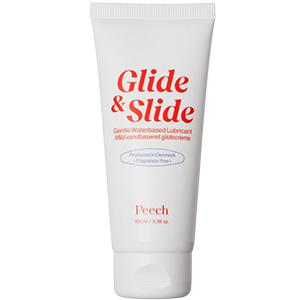Discharge - the vaginas superpower
Everyone with a vagina experiences it - few talk about it. The very word "discharge" doesn't sound like something to be proud of - but you should be. Despite the fluid's many properties, the wording still manages to indicate that it's something we should distance ourselves from. Like it's something that just needs to come "out".
Discharge is not something we should distance ourselves from - actually quite the opposite. It's a quality we should value, and it should have a name that reflects all its superpowers. But what is discharge? And what do we need it for?
Written by sexologist Mille Shade Weincke.
What is vaginal discharge?
Discharge is a secretion that flows out of the vagina on a daily basis. It consists of a mixture of fluid from the cervical glands and the vaginal mucosa, as well as microorganisms and lactic acid bacteria. Discharge is usually a clear milky-white colour, but varies in appearance and consistency depending on where you are in your life and particularly in your cycle. All people with a vagina experience vaginal discharge, which usually starts 1-2 years before puberty and typically continues until after menopause - the amount of discharge varies from person to person.
We are not used to talking nicely about our discharge - we may suppress it or give it too little attention. There's generally a negative connotation to the term, perhaps because we're used to associating vaginal discharge with every conceivable sexual disease and infection: if you search for "discharge" online, "treatment suggestions" and disease symptoms are the first things that come up. Generally, discharge is not something that needs treatment - it's a super-intelligent tool. Here are 3 reasons why:
1. You can sense your cycle through your discharge
If you still have a menstrual cycle, the consistency of your discharge will change during your cycle due to a shift in hormone levels. Right after your period, you will usually experience no or very little discharge, and after a few days it will have a slightly dry texture.
As you approach ovulation, the secretion will become creamier in texture, and during ovulation the texture will change to a wet and smooth texture, very similar to egg whites. This makes it easier (from an evolutionary perspective) for the vagina to be fertilised, as sperm are more easily lead to the uterus. As the ovulation window closes and menstruation approaches, the texture will again become sticky or dry - a new cycle is underway.
For curiosity's sake, try examining the consistency of your vaginal discharge with your fingers. Tracking vaginal discharge is not recommended as the only contraceptive method, as there may be uncertainties and it is easy to confuse discharge with lubrication fluid (the fluid produced when the vagina and vulva become aroused) or semen. - However, keeping an eye on the development of consistency can give you a very good idea of where you are in your cycle.
2. Discharge is the ultimate cleanser
Discharge is one of the most important secretions in the body. This is because the mixture of micro-organisms and lactic acid bacteria maintains the natural pH of the vagina and the optimal environment for bacteria to survive.
The discharge is therefore part of the self-cleaning system of the vagina - the ultimate defence mechanism to prevent bacteria from reaching the uterus and ovaries.
3. Discharge is the mouthpiece of the vagina - what does it tell you
Although discharge is the vagina's super-cleanser, it can't always keep its guard up - even the greatest heroes sometimes fall. If this is the case, the discharge makes sure to communicate it to you, loud and clear.
If the environment in the vagina is out of balance, the discharge will be one of the first things to change. So keep an eye out for changes in colour, smell and texture. If it changes out of the ordinary, it is telling you that something is not right. Go to the doctor, get checked, get tested. It could be a sign of a sexually transmitted disease or infection.
Discharge is the ultimate cleanser, communicator and defender of the abdomen. We must remember to appreciate this wonder fluid. It may be there, in fact it should be. It is, after all, the vagina's best friend. We could start by calling it something nicer - a suggestion: vaginal supersecretion.
Read also: How to get tested for STDs
Read also: Our guide to caring for your vagina





